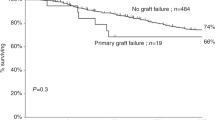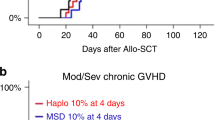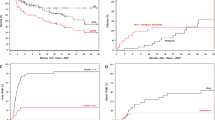Abstract
The relative benefit of allogeneic bone marrow transplantation (alloBMT) vs autologous BMT (autoBMT) for patients with relapsed or refractory Hodgkin’s disease (HD) or non-Hodgkin’s lymphoma (NHL) remains uncertain. Toxicity from graft-versus-host disease (GVHD) may diminish the potential benefits both of graft-versus-tumor activity and of receiving uncontaminated donor marrow stem cells. From 1987 to 1995, 27 adults (ages 18–60 years; median 36) underwent alloBMT for lymphoma after failure of standard chemotherapy. Twenty-one had NHL and six had HD (nodular sclerosis). Thirteen patients had primary refractory disease or chemotherapy-resistant relapses; two of these had relapsed after autoBMT. Three patients had untested relapses (one of them had relapsed after autoBMT), and 11 had chemotherapy-sensitive relapses. Twenty-four received HLA-matched bone marrow from a sibling (one twin); three received haploidentical marrow cells. Nine (33%) died from lymphoma. Eleven (41%) died of treatment-related causes. Opportunistic infections were a substantial problem leading to eight of these deaths (30%). Six patients (22%) survive free of lymphoma 17–70 months post-BMT (median, 56 months); four had had sensitive relapses, one had had a resistant relapse, and one had had nontested relapse. Three have chronic GVHD (limited in one; extensive in two). One HD patient who had relapsed after autoBMT remains in remission 19 months after alloBMT. No therapy-related myelodysplasia has been observed. We conclude that alloBMT has substantial morbidity in heavily pretreated lymphoma patients due to acute toxicity, infections and GVHD. However, 22% of our HD/NHL patients have had long-term disease-free survival.
This is a preview of subscription content, access via your institution
Access options
Subscribe to this journal
Receive 12 print issues and online access
$259.00 per year
only $21.58 per issue
Buy this article
- Purchase on Springer Link
- Instant access to full article PDF
Prices may be subject to local taxes which are calculated during checkout
Similar content being viewed by others
Author information
Authors and Affiliations
Rights and permissions
About this article
Cite this article
Dann, E., Daugherty, C. & Larson, R. Allogeneic bone marrow transplantation for relapsed and refractory Hodgkin’s disease and non-Hodgkin’s lymphoma. Bone Marrow Transplant 20, 369–374 (1997). https://doi.org/10.1038/sj.bmt.1700904
Received:
Accepted:
Issue Date:
DOI: https://doi.org/10.1038/sj.bmt.1700904
Keywords
This article is cited by
-
An Update on the Use of Immunotherapy in the Treatment of Lymphoma
Current Hematologic Malignancy Reports (2017)
-
Allogeneic transplantation after reduced-intensity conditioning with fludarabine–CY for both indolent and aggressive lymphoid malignancies
Bone Marrow Transplantation (2014)
-
The role of hematopoietic SCT in adult Burkitt lymphoma
Bone Marrow Transplantation (2013)
-
Surface antigenic profiling of stem cells from human omentum fat in comparison with subcutaneous fat and bone marrow
Cytotechnology (2012)
-
Clinical outcomes of late rather than early full-donor chimerism in patients with advanced lymphomas receiving nonmyeloablative allogeneic hematopoietic SCT
Bone Marrow Transplantation (2008)



